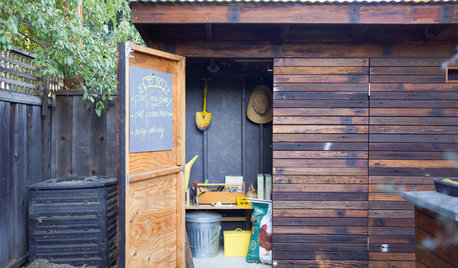organic gardening woes
Drewet88
10 years ago
Related Stories

STORAGEDownsizing Help: Shelve Your Storage Woes
Look to built-in, freestanding and hanging shelves for all the display and storage space you need in your smaller home
Full Story
PRODUCT PICKSGuest Picks: Solve Your Bathroom Storage Woes
Keep your bath neat and organized with these attractive cabinets, shelves and hampers
Full Story
INSPIRING GARDENSFrom Concrete Lot to Gracious Organic Garden in Seattle
Plants, pests and even weeds have a place in this landscape, which offers an edible bounty and a feast for the eyes
Full Story
OUTBUILDINGSGet It Done: Overhaul and Organize Your Garden Shed
Consider these tips for outdoor storage space that’s accessible and attractive
Full Story
GARDENING GUIDESOrganic Matters: Thwart Insect Pests With Trap Crops
Add a few sacrificial plants to your garden to lure insects away from the harvest
Full Story
LAUNDRY ROOMS7-Day Plan: Get a Spotless, Beautifully Organized Laundry Room
Get your laundry area in shape to make washday more pleasant and convenient
Full Story
ORGANIZING21 Tips for Organizing Your Stuff
Restore order at home with these ideas for tidying up cupboards, shelves, doors and more
Full Story
REMODELING GUIDESTile Floors Help a Hot Home Chill Out
Replace your hot-weather woes with a cool feel for toes when you treat your floors to deliciously refreshing tile
Full Story
GARDENING GUIDESHow to Switch to an Organic Landscape Plan
Ditch the chemicals for a naturally beautiful lawn and garden, using living fertilizers and other nontoxic treatments
Full Story
GARDENING GUIDESGreat Design Plant: Knock Out Roses
As glorious as their high-maintenance kin for a fraction of the work, Knock Out roses make even beginners look like garden stars
Full StoryMore Discussions






ticodxb
Drewet88Original Author
Related Professionals
West Milford Landscape Architects & Landscape Designers · Surprise Landscape Architects & Landscape Designers · Apollo Beach Landscape Contractors · Cambridge Landscape Contractors · Commack Landscape Contractors · Concord Landscape Contractors · Conroe Landscape Contractors · Harvey Landscape Contractors · La Verne Landscape Contractors · River Ridge Landscape Contractors · Yuba City Landscape Contractors · Chandler Decks, Patios & Outdoor Enclosures · Fort Lee Decks, Patios & Outdoor Enclosures · Wildomar Decks, Patios & Outdoor Enclosures · Winchester Center Stone, Pavers & ConcreteDrewet88Original Author
Kimmsr
Drewet88Original Author
Kimmsr
pnbrown
Drewet88Original Author
elisa_z5